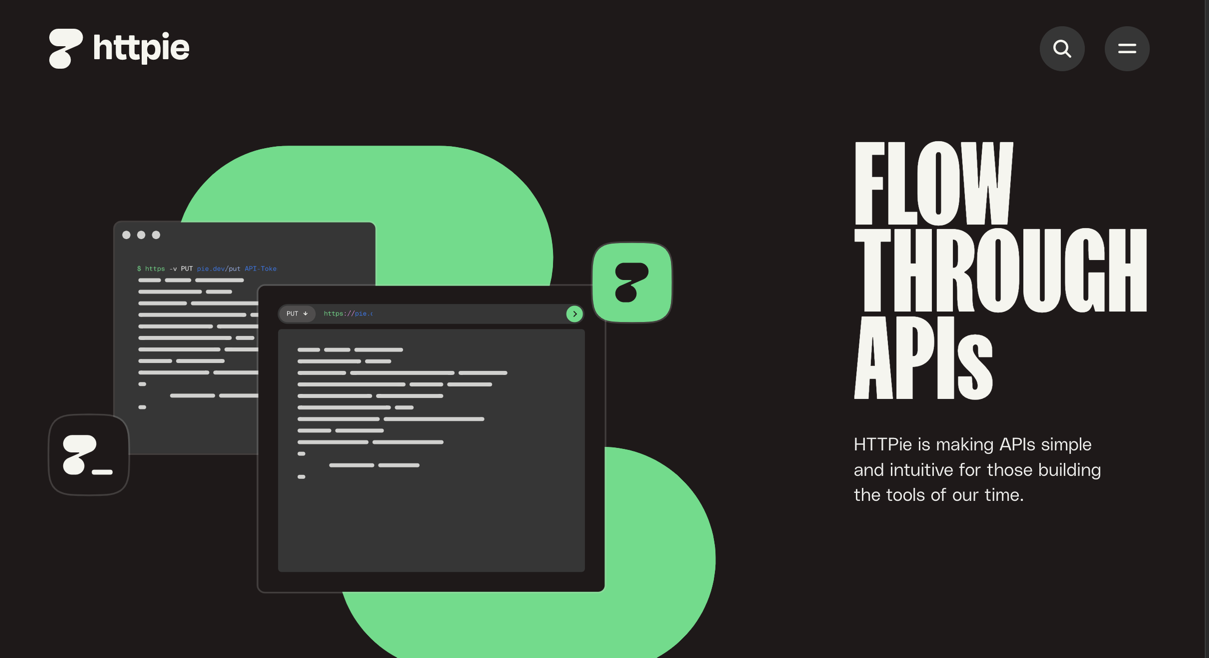
HTTPie
Open Website-
Tool Introduction:AI‑powered HTTP client for faster API testing, debugging, and docs.
-
Inclusion Date:Nov 07, 2025
-
Social Media & Email:
Tool Information
What is HTTPie AI
HTTPie AI is an AI-powered assistant inside HTTPie that turns natural language into precise API requests. It helps developers and testers build HTTP requests, set headers and JSON bodies, and explain responses or errors in plain English. Available in the terminal and in HTTPie for Web & Desktop, it streamlines API testing, debugging, and exploration across REST and GraphQL. It can also suggest fixes, generate httpie or cURL commands, and guide authentication, making everyday API work faster and more reliable from first call to integration.
Main Features of HTTPie AI
- Natural language to requests: Describe what you want, and it generates HTTP methods, URLs, headers, and payloads.
- Response and error explanations: Interprets status codes, error messages, and payloads with actionable suggestions.
- Command generation: Produces ready-to-run httpie and cURL commands for terminal workflows.
- REST and GraphQL support: Helps craft REST endpoints and GraphQL queries or mutations with variables.
- Auth helpers: Assists with common authentication schemes like Bearer tokens and Basic Auth.
- Schema awareness: When you provide API docs or an OpenAPI schema, it can reference endpoints and parameters.
- Reusable snippets: Save, edit, and reuse requests; maintain history with context.
- Works everywhere: Use the assistant in the command-line client or in HTTPie’s web & desktop app.
Who Can Use HTTPie AI
HTTPie AI suits backend and frontend developers, QA engineers, SREs, DevOps, API consumers, and technical writers who need a faster way to explore, test, and document HTTP services. it's helpful for onboarding to unfamiliar APIs, building prototypes, debugging REST/GraphQL calls, and creating shareable request collections for teams.
How to Use HTTPie AI
- Open HTTPie in the terminal or launch HTTPie for Web & Desktop and sign in if required.
- Enable the AI assistant and describe your goal in natural language (e.g., “GET user by ID with Bearer token”).
- Review the generated request, including method, URL, headers, and JSON body.
- Run the request and inspect the response; ask the assistant to explain results or errors.
- Iterate by refining prompts, adding params, or adjusting authentication.
- Export the httpie or cURL command, save the request as a snippet, or share it with your workspace.
HTTPie AI Use Cases
Teams use HTTPie AI to speed up API testing in SaaS backends, prototype integrations with payment or messaging APIs, debug e-commerce and logistics endpoints, verify data pipelines and webhooks, document endpoints for internal platforms, and support mobile app backends with quick REST and GraphQL queries during development and CI troubleshooting.
HTTPie AI Pricing
HTTPie AI is available within HTTPie’s web & desktop and terminal experiences. Many users can start on a free tier, while paid plans are available for advanced features and team collaboration. AI usage may include fair-use limits or credits, and trials are commonly offered so teams can evaluate before upgrading.
Pros and Cons of HTTPie AI
Pros:
- Accelerates API testing and debugging with natural language prompts.
- Generates accurate httpie and cURL commands for CLI workflows.
- Clear explanations of responses and errors reduce trial-and-error.
- Supports REST and GraphQL, with optional schema guidance.
- Works across terminal and web/desktop for flexible usage.
Cons:
- AI suggestions still require developer review for correctness and security.
- May rely on internet access and have usage limits on free plans.
- Complex OAuth or custom auth flows might need manual configuration.
FAQs about HTTPie AI
-
Does HTTPie AI work with existing httpie commands?
Yes. It can generate and refine httpie commands that you can run directly in the terminal or save for later.
-
Can it help with GraphQL?
It can draft queries, mutations, and variables, and explain errors returned by GraphQL servers.
-
Does it support authentication?
It assists with common auth methods such as Bearer tokens and Basic Auth, and can guide header setup.
-
Can I use my API schema?
If you provide an OpenAPI or similar schema, the assistant can reference endpoints and parameters to improve suggestions.



